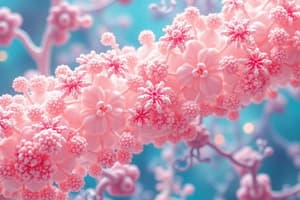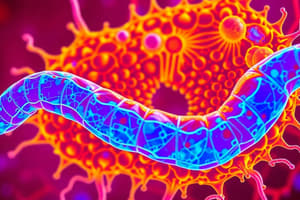Podcast
Questions and Answers
What is the role of the SRP in protein translocation to the endoplasmic reticulum?
What is the role of the SRP in protein translocation to the endoplasmic reticulum?
- It synthesizes the entire protein before translocation.
- It cleaves the signal sequence before translocation.
- It facilitates the folding of the newly synthesized protein.
- It binds to the ribosome and pauses translation. (correct)
What event occurs immediately after the SRP binds to the SRP receptor on the ER?
What event occurs immediately after the SRP binds to the SRP receptor on the ER?
- Translocation of the protein across the membrane begins.
- Signal sequences are cleaved from the protein.
- The SRP leaves the ribosome and translation resumes. (correct)
- The ribosome detaches from the mRNA.
Which process describes the movement of the protein across the ER membrane during translation?
Which process describes the movement of the protein across the ER membrane during translation?
- Non-cotranslational translocation
- Post-translational translocation
- Co-translational translocation (correct)
- Transcriptional translocation
What happens to the N-terminal signal sequences after the SRP-mediated translocation process?
What happens to the N-terminal signal sequences after the SRP-mediated translocation process?
What is the function of the translocon during protein translocation?
What is the function of the translocon during protein translocation?
What happens to Ran when it is bound to the nuclear transport receptor?
What happens to Ran when it is bound to the nuclear transport receptor?
Where are most mitochondrial proteins encoded?
Where are most mitochondrial proteins encoded?
What occurs to proteins as they are translocated into mitochondria?
What occurs to proteins as they are translocated into mitochondria?
What function does the endoplasmic reticulum (ER) serve?
What function does the endoplasmic reticulum (ER) serve?
Which of the following is true about the nuclear transport receptor?
Which of the following is true about the nuclear transport receptor?
Which process involves sorting proteins into chloroplasts?
Which process involves sorting proteins into chloroplasts?
What percentage of genes are involved in synthesis related to the ER?
What percentage of genes are involved in synthesis related to the ER?
Which of the following is NOT a mechanism of protein sorting mentioned?
Which of the following is NOT a mechanism of protein sorting mentioned?
What kind of proteins mainly require active transport to enter the nucleus?
What kind of proteins mainly require active transport to enter the nucleus?
Which protein family competes with cargo for binding to the import receptor?
Which protein family competes with cargo for binding to the import receptor?
What must occur for import to require high Ran-GTP levels in the nucleus?
What must occur for import to require high Ran-GTP levels in the nucleus?
What role do GTP-binding proteins play in the context of nuclear transport?
What role do GTP-binding proteins play in the context of nuclear transport?
Which statement accurately reflects the process of cargo protein release from the import receptor?
Which statement accurately reflects the process of cargo protein release from the import receptor?
What happens when Ran-GAP is depleted in a cell?
What happens when Ran-GAP is depleted in a cell?
What is the function of the GEF in relation to GTP-binding proteins?
What is the function of the GEF in relation to GTP-binding proteins?
Which of the following accurately describes the nuclear pore complex?
Which of the following accurately describes the nuclear pore complex?
What characterizes small GTP-binding proteins in their role as molecular switches?
What characterizes small GTP-binding proteins in their role as molecular switches?
How do larger proteins typically enter the nucleus?
How do larger proteins typically enter the nucleus?
What designation is given to the first signal sequence during protein translocation?
What designation is given to the first signal sequence during protein translocation?
What is cleaved off by signal peptidase in the ER lumen?
What is cleaved off by signal peptidase in the ER lumen?
Which orientation results when the start-transfer sequence is positioned correctly?
Which orientation results when the start-transfer sequence is positioned correctly?
What is true regarding multipass membrane proteins?
What is true regarding multipass membrane proteins?
What type of glycosylation occurs on asparagine side-chains in the ER?
What type of glycosylation occurs on asparagine side-chains in the ER?
What is the primary role of signal sequences in protein sorting?
What is the primary role of signal sequences in protein sorting?
What is one function of protein glycosylation?
What is one function of protein glycosylation?
What happens during the Ran-GTPase cycle regarding nuclear import of proteins?
What happens during the Ran-GTPase cycle regarding nuclear import of proteins?
How do proteins get targeted to mitochondria and chloroplasts post-translationally?
How do proteins get targeted to mitochondria and chloroplasts post-translationally?
Where does glycosylation of proteins primarily occur?
Where does glycosylation of proteins primarily occur?
What is the mechanism by which the signal recognition particle (SRP) functions?
What is the mechanism by which the signal recognition particle (SRP) functions?
Which amino acid is specifically mentioned in the glycosylation sequence?
Which amino acid is specifically mentioned in the glycosylation sequence?
What role does protein glycosylation play in the endoplasmic reticulum?
What role does protein glycosylation play in the endoplasmic reticulum?
What role can protein glycosylation play in protein interaction?
What role can protein glycosylation play in protein interaction?
Which of the following correctly describes transmembrane proteins during their insertion into the endoplasmic reticulum?
Which of the following correctly describes transmembrane proteins during their insertion into the endoplasmic reticulum?
Which statement about the sugar chain in glycosylation is incorrect?
Which statement about the sugar chain in glycosylation is incorrect?
Which organelle is associated with post-translational import of proteins primarily via signal sequences?
Which organelle is associated with post-translational import of proteins primarily via signal sequences?
What determines whether a protein will remain in the cytosol or be directed elsewhere?
What determines whether a protein will remain in the cytosol or be directed elsewhere?
What is the first step in the transport of a protein into the nucleus?
What is the first step in the transport of a protein into the nucleus?
Flashcards
Nuclear transport receptor
Nuclear transport receptor
A protein that helps move molecules across the nuclear envelope.
Nuclear localization signal (NLS)
Nuclear localization signal (NLS)
A sequence of amino acids on a protein that signals its entry into the nucleus.
Ran GTPase
Ran GTPase
A small GTP-binding protein that acts as a molecular switch, helping regulate nuclear transport.
GEF (Guanine nucleotide Exchange Factor)
GEF (Guanine nucleotide Exchange Factor)
Signup and view all the flashcards
GAP (GTPase Activating Protein)
GAP (GTPase Activating Protein)
Signup and view all the flashcards
Nuclear import
Nuclear import
Signup and view all the flashcards
Nuclear export
Nuclear export
Signup and view all the flashcards
Nuclear pore complex
Nuclear pore complex
Signup and view all the flashcards
Diffusion barrier
Diffusion barrier
Signup and view all the flashcards
Nuclear lamin
Nuclear lamin
Signup and view all the flashcards
Signal sequences
Signal sequences
Signup and view all the flashcards
Ran
Ran
Signup and view all the flashcards
Importin
Importin
Signup and view all the flashcards
Chaperone Protein
Chaperone Protein
Signup and view all the flashcards
Co-translational translocation
Co-translational translocation
Signup and view all the flashcards
Signal recognition particle (SRP)
Signal recognition particle (SRP)
Signup and view all the flashcards
Translocon
Translocon
Signup and view all the flashcards
Protein folding
Protein folding
Signup and view all the flashcards
ER Signal Sequence
ER Signal Sequence
Signup and view all the flashcards
Cleavage of the Signal Sequence
Cleavage of the Signal Sequence
Signup and view all the flashcards
Signal peptidase
Signal peptidase
Signup and view all the flashcards
Start-transfer sequence
Start-transfer sequence
Signup and view all the flashcards
Stop-transfer sequence
Stop-transfer sequence
Signup and view all the flashcards
Protein Glycosylation
Protein Glycosylation
Signup and view all the flashcards
Where does Protein Glycosylation occur?
Where does Protein Glycosylation occur?
Signup and view all the flashcards
Which amino acid is involved in glycosylation?
Which amino acid is involved in glycosylation?
Signup and view all the flashcards
Where on Asparagine is the sugar chain attached?
Where on Asparagine is the sugar chain attached?
Signup and view all the flashcards
What are the functions of Protein Glycosylation?
What are the functions of Protein Glycosylation?
Signup and view all the flashcards
Nuclear Pore Complex (NPC)
Nuclear Pore Complex (NPC)
Signup and view all the flashcards
Nuclear Envelope
Nuclear Envelope
Signup and view all the flashcards
Nucleolus
Nucleolus
Signup and view all the flashcards
Study Notes
Protein Sorting Overview
- Eukaryotic cells have membrane-bound organelles
- Proteins are sorted by different mechanisms:
- Transport through nuclear pores
- Transport across membranes
- Transport by vesicles
Learning Objectives
- Understand mechanisms for protein targeting to various cellular compartments
- Understand signal sequences
- Understand how proteins are targeted post-translationally to mitochondria and chloroplasts
- Understand how SRP couples translation and translocation of proteins into the endoplasmic reticulum
- Understand how proteins with multiple transmembrane regions are inserted into the endoplasmic reticulum
- Understand protein glycosylation and folding in the ER
Nuclear Envelope Architecture
- The nuclear envelope comprises an outer and inner membrane
- The space between the two nuclear membranes is called the perinuclear space
- Contains nuclear pores
- The inner membrane and outer membrane are linked by nuclear pores
- Nuclear pores allow the transport of molecules between the nucleus and the cytoplasm
- Small proteins can passively diffuse
- Larger proteins need an active process for transport
- Nuclear transport receptors move molecules through the nuclear pores
Nuclear Pore Complexes
- Unstructured protein loops create a diffusion barrier
- Very small proteins (<5 kD) can passively diffuse through nuclear pores. Larger proteins require an active transport process.
- Many proteins enter the nucleus through these pores requiring an active shuttling process
Nuclear Transport Receptors
- Prospective nuclear protein (cargo) binds to the nuclear import receptor
- The nuclear import receptor "lets go" of cargo protein in the nucleus
- GTP-binding proteins (GTPases or monomeric GTPases) are molecular switches
- The "GEF" (guanine nucleotide exchange factor) triggers GTP binding.
- The 'GAP' (GTPase-activating protein) triggers GTP hydrolysis.
- GTP hydrolysis drives nuclear transport
- Ran GTPase competes with cargo for binding to the receptor
Mitochondrial Protein Import
- Most mitochondrial proteins are encoded in the nuclear genome
- Proteins are unfolded as they are translocated across both membranes simultaneously
- Binding to import receptors in the outer membrane
- Protein translocator in the inner membrane
- Proteins are then translocated into the matrix
- Proteins are refolded within the mitochondrion
ER Protein Import - SRP and Co-translational translocation
- SRP (signal recognition particle) binds signal sequence and slows/pauses translation
- SRP binds to the SRP receptor on the ER
- SRP leaves and ribosome engages translocation channel (aka "translocon")
- Translation resumes and protein is translocated across the bilayer
- Signal sequence is cleaved off protein by signal peptidase
- Protein folds in the ER lumen
Transmembrane Proteins
- Proteins with transmembrane segments are directed into the ER membrane in a "co-translational translocation"
- First segment (start-transfer sequence)
- Second segments (stop-transfer sequence)
- The mechanism dictates the direction of the protein in the membrane (N-terminus in the lumen)
Glycosylation
- Many proteins undergo glycosylation (N-linked) in the ER
- Sugar chains attach to asparagine in the ER
- Never occurs in the cytosol
Multipass Membrane Proteins
- Multipass membrane proteins contain multiple stop-transfer and start-transfer sequences
- These sequences relate to translocation and not translocation.
Studying That Suits You
Use AI to generate personalized quizzes and flashcards to suit your learning preferences.



